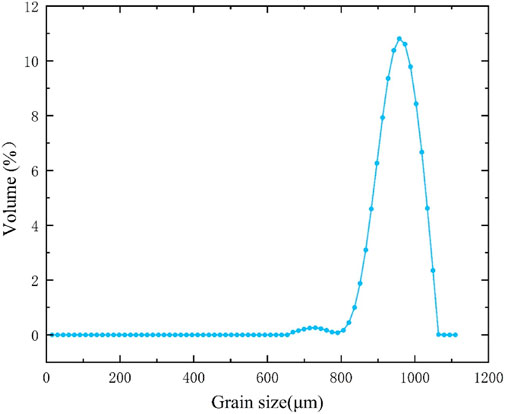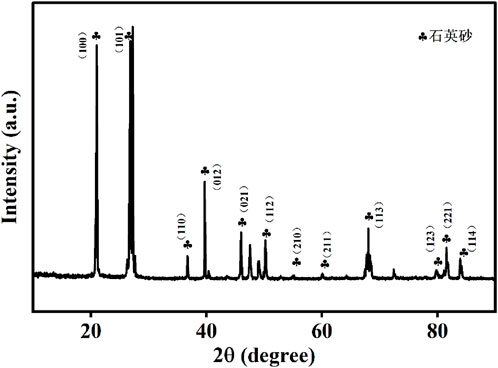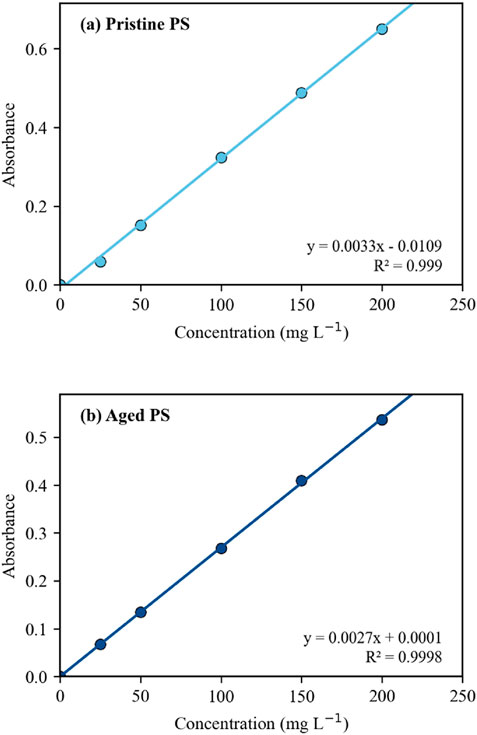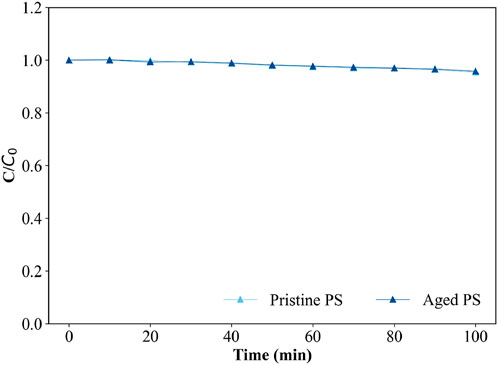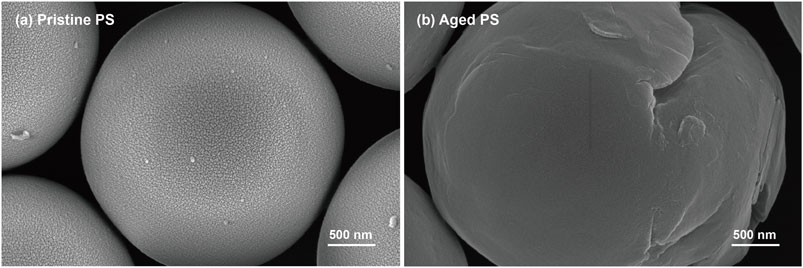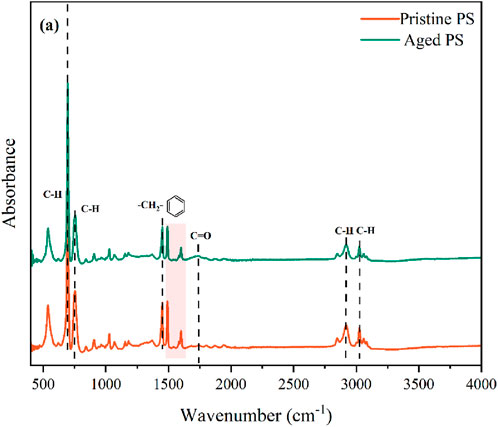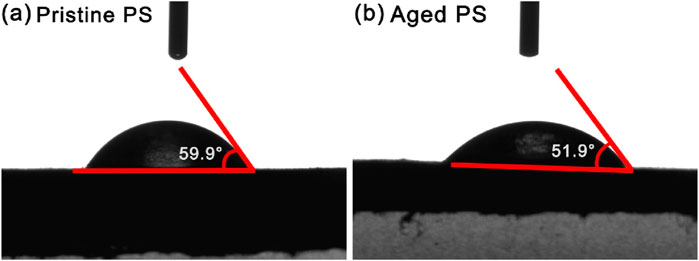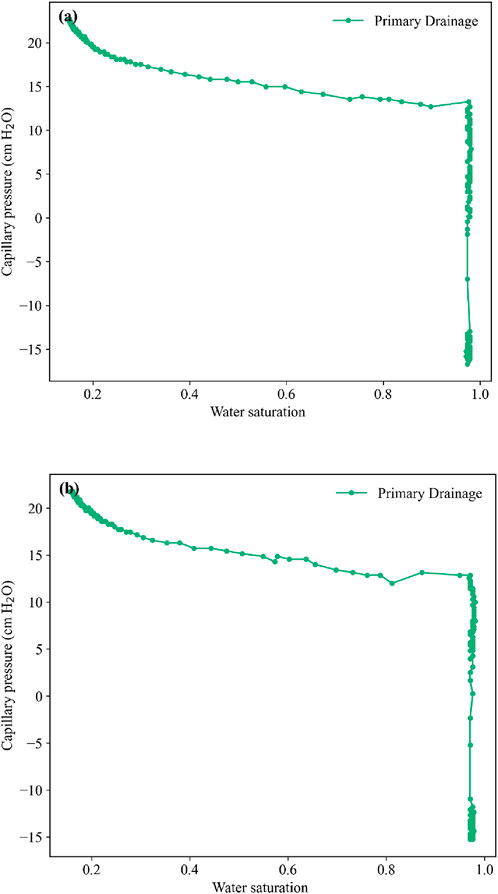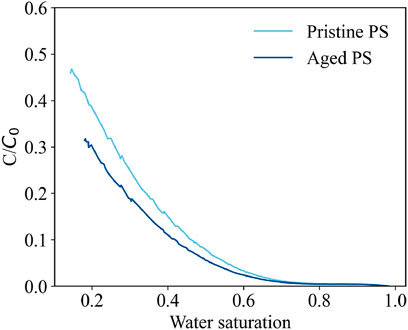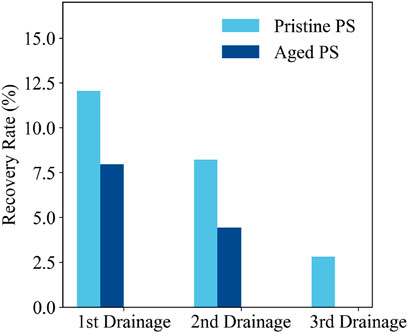- 1School of Marine Sciences, Sun Yat-Sen University, Guangzhou, China
- 2Co-Innovation Center of Efficient Processing and Utilization of Forest Resources, College of Materials Science and Engineering, Nanjing Forestry University, Nanjing, China
- 3Zhejiang Zhouhuan Environmental Engineering Design Co., Ltd., Zhoushan, China
- 4National Key Laboratory for Development and Utilization of Forest Food Resources, Co-Innovation Center for Sustainable Forestry in Southern China, Nanjing Forestry University, Nanjing, China
Understanding the aging processes of microplastics (MPs) and their behavior under dynamic wet-dry cycles is critical for accurate environmental risk assessment, particularly in unsaturated zones. This study investigates the impact of aging on the retention and remobilization dynamics of polystyrene (PS) microplastics in unsaturated porous media. We employed light-aged PS MPs and conducted column experiments using sea sand under multiple wetting-drying cycles. Key physicochemical properties of the MPs were characterized, and their retention and remobilization were quantified by monitoring effluent concentrations.Aging significantly altered MP properties, increasing their surface negative charge and hydrophilicity. Consequently, aging suppressed the remobilization of retained MPs during drying phases. After five cycles, the total retained fraction of aged MPs (76.88%) was consistently higher than that of pristine MPs (72.83%). Remobilization was primarily driven by mobile air-water interfaces (AWI) once water saturation fell below a critical threshold of approximately 0.6. Although aging increased electrostatic repulsion (which hinders retention), it also increased hydrophilicity, which significantly weakened AWI-driven remobilization during drying. This retention-promoting mechanism (reduced AWI remobilization) outweighed the opposing effect of electrostatic repulsion, leading to greater overall retention of aged MPs. This study highlights the complex regulatory role of aging on MP fate and provides critical insights for assessing the environmental risks of aged microplastics in dynamic unsaturated systems.
1 Introduction
Microplastics (MPs), defined as synthetic polymer particles, fragments, or fibers smaller than 5 mm, constitute an emerging global contaminant (Li et al., 2023). Fueled by escalating plastic consumption and continuous environmental degradation of plastic waste, global MP concentrations are projected to reach ∼10 million metric tons by 2040 (Lau et al., 2020). Pervasive across terrestrial, aquatic, and atmospheric compartments, MPs pose significant ecological threats (Koelmans et al., 2022). Unsaturated zones (e.g., soil vadose layers, intertidal sediments, seasonally arid soils) serve as pivotal pathways for MP transit from surface environments to groundwater while simultaneously acting as long-term retention sites where aging, co-contaminant associations, and episodic remobilization may occur (Feng et al., 2024). However, predicting their behavior in these systems is complicated by the interplay of two crucial factors: the inevitable aging processes that fundamentally alter their physicochemical properties, and the dynamic wetting-drying cycles driven by precipitation, evaporation, or tides, which govern transport. Understanding the combined influence of these co-occurring processes on MP fate remains limited, representing a critical knowledge gap for accurate environmental risk assessment.
Once released into the environment, plastics undergo inevitable aging processes that fundamentally alter their physicochemical properties (Lu et al., 2023). Aged microplastics can develop enhanced ecotoxicity and modified environmental behaviors compared to pristine counterparts (Abaroa-Pérez et al., 2022). Microplastic aging constitutes a complex transformation driven by multifaceted environmental drivers, including: Photo-oxidative degradation (UV radiation, oxygen), Thermal fluctuations, Aqueous chemistry (pH, salinity), Mechanical abrasion, and Biological activity (Lu et al., 2023). Sunlight, particularly ultraviolet (UV) radiation, serves as the primary driver of plastic photo-oxidative degradation in environmental systems. UV exposure initiates polymer chain scission, incorporating oxygen atoms and generating surface functional groups (e.g., carbonyls) on microplastics (Yu et al., 2024). This process increases material embrittlement, ultimately causing fragmentation and particle size reduction (Wang et al., 2023). These aging-induced transformations profoundly govern microplastic environmental mobility. Critically, aging typically increases the surface negative charge and hydrophilicity of MPs. This wettability shift alters transport behavior in porous media, modifies interfacial interactions at air-water boundaries and increases adsorption affinity for hydrophilic contaminants (Yu et al., 2024). Aging exerts dual competing influences on microplastic transport in porous media: increased surface roughness promotes retention by expanding attachment sites, while fragmentation into smaller particles enhances mobility (Ren et al., 2021). Smaller particles exhibit greater bioavailability—facilitating organismal ingestion, crossing biological barriers, and amplifying trophic transfer risks (Akhatova et al., 2022). Collectively, these aging-induced transformations govern microplastic environmental mobility, pollutant carrier potential, and ecotoxicological impacts. Critically, studies restricted to pristine microplastics suffer inherent limitations in representing environmental realism. Research on aged particles is therefore imperative to accurately resolve environmental dynamics, assess long-term fate, and quantify ecosystem risks.
Microplastic (MP) transport through porous media constitutes a dynamically complex process regulated by multifactorial interactions. The environmental behavior and ultimate fate of MPs are determined by interdependent properties of the particles themselves, the porous matrix, water saturationand the resident porewater chemistry (Gao et al., 2021). Current unsaturated soil studies primarily examine how MP properties (size, density, hydrophobicity) and media characteristics (grain size, pH, ionic strength [IS], cations, dissolved organic matter [DOM]) govern retention (Wang et al., 2022). Experimental approaches typically employ one-dimensional packed column experiments under controlled unsaturated conditions, achieved by regulating water content or pre-drying. Ling et al. documented substantially decreased MP recovery in breakthrough curves as saturation declined from 100% to 50%, demonstrating enhanced retention due to air-water interface (AWI) formation and thinner water films (Ling et al., 2022). Flow velocity effects exhibit greater complexity in unsaturated media. Ionic strength exerts a stronger influence on transport than in saturated systems, largely because reduced pore-water flow areas decrease separation distances between MPs and solid matrices (Dong et al., 2022). MP hydrophobicity—determining AWI affinity—critically regulates unsaturated transport. Mitropoulou et al. observed higher retention for larger MPs via AWI attachment (Mitropoulou et al., 2013), while Morales et al. reported DOM-enhanced retention at the AWI through altered surface hydrophobicity (Morales et al., 2011). Wang et al. systematically compared ionic strength and cation effects on aged versus pristine MPs in unsaturated sand, consistently finding enhanced retention via electrical double layer compression and reduced electrostatic repulsion at higher IS or with polyvalent cations. Aged MPs showed weaker IS sensitivity due to increased surface negative charge (Wang et al., 2022). Feng et al. observed reduced MP release from unsaturated versus saturated columns, with aging enhancing mobility of hydrophilic MPs in unsaturated media (Feng et al., 2024), though other studies note aging-induced surface roughness increases retention (Feng et al., 2022). Most studies investigate MPs under static unsaturated conditions or single infiltration events, despite natural vadose zones experiencing highly dynamic moisture regimes driven by rainfall, evaporation, root uptake, and water table fluctuations. Wetting-drying cycles significantly enhance vertical MP migration, likely through soil structural modification, pore-water pressure shifts, and altered hydrodynamic forces. These cycles also accelerate MP aging (O’connor et al., 2019); Ranjan et al. (2023) demonstrated they promote mechanical weathering and fragmentation into secondary particles, significantly increasing penetration depth in porous media. Using tidal simulations, Feng et al. demonstrated capillary fringe fluctuations effectively remobilize retained MPs and accelerate groundwater transport, highlighting hydrological dynamics’ critical role (Feng et al., 2023). Research on microplastic (MP) transport in unsaturated porous media has identified key influencing factors, yet understanding of long-term behavior under co-occurring hydrological dynamics and aging processes remains limited. The complex air-water interface (AWI) interactions inherent to unsaturated systems introduce significant transport complexity.
In unsaturated porous media, where solid, liquid, and discontinuous/continuous gas phases coexist, air-water interfaces (AWIs) form within pore spaces (Crist et al., 2005; Dong et al., 2022). These interfaces introduce three primary retention mechanisms: AWI attachment, air-water-solid (AWS) contact line retention, and capture within thin water films. Since water saturation governs AWI area and water film thickness, capillary retention mechanisms exhibit strong moisture dependence (Huang et al., 2024). Infiltration, drying cycles, or capillary fringe fluctuations mobilize AWIs, exerting substantial forces on retained colloids (Bradford and Torkzaban, 2008). The core remobilization mechanism involves dynamic capillary forces from moving interfaces (Bradford and Torkzaban, 2008). As advancing/receding AWIs pass surface-attached colloids, dynamically changing surface tension generates normal detachment forces (Flury and Aramrak, 2017). These potent interfacial detachment forces constitute the primary remobilization mechanism in unsaturated media, modulated by hydrological dynamics, colloid properties, and fluid chemistry (Wu et al., 2021; He et al., 2023). For instance, during the drying phase, the advancing AWI generates significant detachment forces that can mobilize attached particles; Conversely, during wetting, the re-introduction of water disrupts pre-existing AWIs, also potentially remobilizing particles (Bradford and Torkzaban, 2008). Thus, the creation, movement, and destruction of AWIs during wetting-drying cycles represent the dominant physical processes governing colloid fate. The efficiency of these AWI-driven mechanisms, however, is highly sensitive to the surface properties of the colloids themselves, creating a complex scenario when considering environmentally aged microplastics.
A systematic understanding of how environmental aging modifies MP retention and release dynamics in porous media under realistic hydrologic fluctuations remains critically lacking. While current knowledge predominantly derives from studies under saturated or steady-state unsaturated conditions, these approaches do not capture the ubiquitous, dynamic wetting-drying cycles found in environments such as vadose and intertidal zones. This knowledge gap impedes our ability to predict the transport potential and ultimate fate of aged MPs, hindering reliable environmental risk assessments. Therefore, this study investigates the combined effects of aging on polystyrene (PS) microplastics, specifically examining their retention and remobilization behavior in unsaturated porous media under dynamic wetting-drying cycles. It aims to identify dominant controls governing aged MP retention and release under dynamic hydrologic conditions and quantify their relative contributions. This research is crucial for advancing fundamental understanding of MP behavior in natural surface environments.
2 Materials and methods
2.1 Chemical and porous media preparation
Sodium chloride (NaCl, >99.8% purity, Aladdin) were used. Natural sea sand from Qi’ao Island, Zhuhai, Guangdong Province served as the porous medium. The sand was rinsed repeatedly with ultrapure water until conductivity stabilized, then dried at 50°C and sieved (200-mesh). Laser diffraction analysis Laser diffraction analysis (Malvern Mastersizer 2000, Malvern Istruments, UK) showed particle diameters ranging 141–482 μm with median size (d50) of 275 μm, indicating uniform size distribution (Figure 1). XRD analysis (Figure 2) identified quartz as the dominant phase, evidenced by intense peaks at 2θ = 22° (100), 27° (101), and 40° (012) with high crystallinity. Minor peaks indicated accessory minerals (e.g., feldspar, mica). A broad split peak at 2θ ≈ 68° suggested minor poorly crystalline phases with small crystallite size.
2.2 Aged microplastic preparation
Spherical polystyrene microplastics (PS; 3 μm diameter; Jiangsu Zhichuan Technology Co., Ltd.) were artificially aged according to the method described by Xi et al. (2022). Briefly, 0.5 g of PS particles were ultrasonically dispersed in 200 mL of ultrapure water within a 250 mL quartz tube for 30 min. The resulting suspension was then subjected to photo-aging under a 1000 W mercury lamp at 25°C for 32 days. Following aging, all samples were freeze-dried and stored in the dark. Three parallel samples and one control sample were established for each experimental group. The relative errors among parallel samples were required to be maintained below 10%. The control group was subjected to identical conditions as the experimental groups except for the light treatment, thereby excluding potential interference from evaporation, biodegradation, and other processes. All glassware was thoroughly cleaned with ultrapure water and oven-dried at 50°C prior to use to eliminate potential contaminants. Throughout all experimental procedures, researchers wore cotton laboratory coats and appropriate personal protective equipment (PPE) to prevent sample contamination.
2.3 Porous media and microplastic characterization
Natural sea sand was ground to ∼10 μm and analyzed using Cu-Kα radiation (2θ range: 5°–80°, step size: 0.02°, accuracy: ±0.001°). Surface morphology of pristine/aged MPs was examined by field-emission SEM at 3 kV (10k × magnification). Samples were sputter-coated with Pt (110 kV, 60 s) to prevent charging. FTIR spectra (4,000–400 cm−1) were acquired at 4 cm−1 resolution with 16 scans to identify surface functional groups. Hydrophilicity changes were quantified via contact angle measurements. Deionized water droplets (3 μL) were deposited on compressed MP pellets. Contact angles were averaged from >3 replicates per sample, avoiding edge effects. Zeta potentials (reflecting colloidal stability) of MPs and quartz sand were determined in background solutions using a Zetasizer Nano ZS90 (Malvern). Measurements (25°C) involved 21 scans (0–500 Hz) in a 10 mm cuvette. Values were calculated from electrophoretic mobility via the Smoluchowski equation.
2.4 Column experiments: simulating cumulative retention under wetting-drying cycles
2.4.1 Remobilization of microplastics induced by wetting-drying cycles
This study investigated microplastic remobilization from porous media under wetting-drying cycles by subjecting saturated columns to repeated cycles and monitoring microplastic release. Columns were packed using the wet method to ensure saturation and homogeneity. Degassed ultrapure water was pumped upwards from the column bottom at 9 mL/min, maintaining a 5-cm hydraulic head above the sand surface throughout packing to ensure complete saturation. Packing paused at a height of 15 cm to install pre-calibrated time domain reflectometry (TDR) probes and tensiometers into access ports; these were secured with silicone sealant. Packing then resumed in uniform, saturated layers to the target height while continuously infusing degassed ultrapure water. Following the methodology of Li et al. (2013), both TDR probes and tensiometers were calibrated for each experimental column prior to testing to ensure accurate real-time monitoring of water saturation and capillary pressure.
Following packing, columns were stabilized for at least 24 h. TDR probes and tensiometers monitored water saturation and capillary pressure, confirming stability when readings exhibited no significant fluctuations. Prior to microplastic injection, degassed ultrapure water was infused upwards at 9 mL/min to remove sand debris until effluent showed no visible impurities. The water was then replaced with background electrolyte solution (10 mM NaCl), which was infused at the same flow rate for 10 pore volumes (PV), calculated as described in Equation 1 and Equation 2, until effluent absorbance matched the input solution, establishing consistent physicochemical conditions.
PS microplastic suspensions (100 mg/L in 10 mM NaCl) representing different aging durations (0 days, 32 days) were subsequently introduced into the column at a rate equivalent to 2 PV. Continuous sonication maintained homogeneous suspension concentration during injection. Immediately following microplastic injection, background solution (without microplastics) was flushed through the column until effluent microplastic concentrations became undetectable. Effluent absorbance, measured continuously by UV-Vis spectrophotometry during injection and flushing, enabled determination of microplastic concentrations and calculation of the mass retained in the porous media during the saturated phase.
After achieving stable microplastic retention, the initial drying phase commenced by draining the background solution from the column bottom at 9 mL/min. Drying concluded when effluent flow ceased and water saturation stabilized (Xie et al., 2012). Effluent microplastic concentration was continuously monitored via UV-Vis spectrophotometry during drying, enabling calculation of remobilized mass combined with flow rate data. Immediately following this initial drying, subsequent wetting-drying cycles were performed to simulate hydrological fluctuations remobilizing retained microplastics. Each cycle comprised a wetting phase and a drying phase. During wetting, background electrolyte solution (without microplastics) was slowly pumped into the column at 9 mL/min until the liquid level reached the overflow port at the column top, simulating moisture recharge and enabling remobilization upon contact with the moving aqueous phase.
A stabilization period followed each wetting phase to allow moisture redistribution before initiating the drying phase. Drying proceeded identically to the initial phase, with continuous effluent microplastic concentration monitoring enabling calculation of remobilized mass per cycle. Following the initial drying, two complete additional wetting-drying cycles were performed. Effluent microplastic concentration and remobilized mass were continuously monitored and calculated during all drying phases (including the initial and subsequent cycles). For each experimental batch, blank control tests were conducted. This involved preparing control columns packed solely with sea sand and leaching them with background electrolyte solutions free of microplastics under identical experimental conditions. The effluent from these blank columns was collected and analyzed using ultraviolet-visible (UV-Vis) spectrophotometry. No microplastics were detected in any blank samples, confirming that our experimental setup and operational procedures introduced no contamination.
2.4.2 Cumulative retention under wetting-drying cycles
To investigate microplastic transport under complex hydrodynamic conditions representative of realistic unsaturated porous media, including continuous inputs, this study designed cumulative retention experiments driven by wetting-drying cycles, systematically examining the effects of aging and material type on long-term retention and spatial distribution. Columns were packed, stabilized, and flushed with degassed ultrapure water at a constant flow rate (9 mL/min) to remove fine particles or soluble impurities, preventing interference with microplastic quantification. Subsequently, the columns were equilibrated with at least 10 pore volumes (PV) of background electrolyte solution (10 mM NaCl) to achieve hydraulic equilibrium. Following equilibration, an initial drainage phase established uniform unsaturated initial conditions: solution was drained from the column bottom at 9 mL/min until residual water saturation was reached (effluent flow ceased) for all columns.
Following establishment of the initial unsaturated state, wetting-drying cycles with continuous microplastic input commenced. Each cycle consisted of two phases: (1) Wetting phase: Polystyrene (PS) microplastic suspensions (100 mg/L in 10 mM NaCl; aged 0 days or 32 days) were continuously injected upward through the column bottom at 9 mL/min until the liquid level reached the overflow port, achieving near-saturation without ponding. (2) Drying phase: Solution was drained downward at 9 mL/min. Effluent containing remobilized microplastics was collected, returned to the original suspension reservoir, and homogenized via sonication to maintain constant influent concentration, simulating persistent pollution. Drainage continued until effluent flow ceased. This sequence constituted one cycle. Consecutive repetitions yielded cumulative retention data after 1, 2, and 5 uninterrupted cycles.
Post-experiment, the sand column was sectioned into nine 4-cm segments. Each segment was transferred to a clean 500-mL beaker, oven-dried at 70°C, and subjected to microplastic extraction via density flotation. A total of 150 mL of saturated NaCl solution (density 1.20 g/mL) was added to each dried sample, followed by 20-min sonication to release microplastics. The supernatant containing microplastics was transferred to 50-mL centrifuge tubes and centrifuged at 4,500 rpm for 10 min. The final supernatant was diluted to volume in 100-mL colorimetric tubes, and microplastic mass per layer was quantified colorimetrically using a standard curve. Following the experiment, triplicate measurements were performed for each subsample obtained through stratified sampling to quantify retained microplastics in the sand profile, ensuring the reliability of quantitative results.
2.5 Microplastic quantification methods
The effectiveness of ultraviolet-visible (UV-Vis) spectrophotometric quantification was validated through calibration curves established for both pristine and differentially aged polystyrene (PS) microplastics. Microplastic (MP) concentrations in effluent were quantified using UV-Vis spectrophotometry (UV 2800 S) by measuring optical density at characteristic wavelengths (238 nm for PS). Calibration curves exhibited excellent linearity (R2 > 0.999) within the experimental concentration range (Figure 3).
MP suspension stability was verified by monitoring absorbance at 238 nm over 100 min at 10-min intervals. No significant settling occurred (Figure 4), with normalized concentration ratios (C/C0) consistently >0.95. During column experiments, suspensions were continuously stirred at 1,000 rpm to maintain homogeneity and minimize error. To maintain suspension homogeneity during column experiments, continuous agitation was implemented using an ultrasonic cleaner and magnetic stirrer.
2.6 Data processing and calculations
To quantitatively evaluate the retention and remobilization dynamics of microplastics under the experimental conditions, several key metrics were calculated from the collected data. This section outlines the definitions and formulas used for this analysis.
2.6.1 Remobilization and retention metrics
The efficiency of MP remobilization during the drying phases was assessed using the Relative Release Recovery (%), a metric adapted from Bradford and Torkzaban (2008) and defined as: (Mass of MPs released in a drying phase/Mass of MPs retained in the column at the start of that cycle) × 100.
To evaluate the long-term fate of MPs under continuous input and cyclic wetting-drying, the Cumulative Retention (%) was calculated after 1, 2, and 5 cycles. This metric represents the overall retention efficiency of the porous medium and is defined as: (Total MP mass retained in the column/Total MP mass injected) × 100. Furthermore, to assess the mass balance and potential particle loss during the post-experiment extraction process, the Packing Material Recovery (%) was determined by flotation extraction using the following formula: (Total MP mass recovered/Total MP mass injected) × 100. The loss rate (%) was derived from the difference: Cumulative retention recovery - Packing material recovery.
2.6.2 Physical properties of the porous medium
The fundamental physical properties of the packed column, which influence hydraulic and transport behavior, were determined as follows. Porosity (φ), the ratio of void volume to total volume, was calculated using measured particle density (ρp = 2.62 g/cm3) and bulk density (ρb = 1.64 g/cm3):
Based on the calculated porosity and the column dimensions (radius r, length L), the Pore Volume (PV, mL), a critical parameter for standardizing the experimental flow, was calculated as:
where r is column radius (cm) and L is length (cm). Calculated PV = 550 mL.
3 Results and discussion
3.1 Physicochemical properties of aged microplastics
The physicochemical properties of aged microplastics are presented in Figure 5. Pristine PS microspheres maintained their initial spherical morphology with smooth surfaces. After 32 days of aging, the microspheres exhibited characteristic surface flaking and distinct cracking. FTIR spectra (Figure 6) demonstrated significant chemical alterations during aging. A new peak emerged at 1738 cm−1, attributed to C=O stretching vibrations, with intensity increasing over time, indicating the introduction of oxygen-containing functional groups (Xie et al., 2012). Concurrently, the C-H bending vibration peak at 1,449 cm−1 (associated with -CH2-) weakened, suggesting alkyl chain scission, collectively confirming surface oxidation and polymer chain degradation. Contact angle measurements (Figure 7) revealed a significant decrease for aged PS, indicating enhanced hydrophilicity (θc < 90° signifies hydrophilicity (Ouyang et al., 2022)). This shift is primarily attributed to the generation of polar oxygen-containing groups during aging. Increased surface roughness (cracks, folds, pores) further enhanced hydrophilicity by increasing the effective surface area for water interaction. Aging for 32 days substantially increased the absolute value of the PS zeta potential from 29.76 mV to 51.43 mV, indicating enhanced surface electronegativity. This increase is primarily caused by the dissociation of introduced oxygen-containing functional groups, generating negative surface charges. Furthermore, aging-induced surface cracks increased the effective surface area, exposing more charged sites and enhancing negative charge density, consequently elevating the zeta potential magnitude.
3.2 Re-release behavior of aged microplastics in unsaturated media
3.2.1 Hydrodynamic characteristics of aged microplastics during wetting-drying cycles
Cumulative microplastic retention in unsaturated porous media is governed by complex interfacial processes and hydrological dynamics. To assess the long-term impact of aging on microplastic mobility under realistic unsaturated conditions, wetting-drying cycles were employed to examine remobilization mechanisms under complex hydrodynamics. Real-time monitoring of water saturation (Sw) and capillary pressure (Pc) dynamics enabled in-depth analysis of hydrodynamic characteristics during these cycles, revealing Sw/Pc evolution patterns and their influence on air-water interface (AWI) behavior.
Following saturated-phase retention, the initial drainage phase commenced. Figure 8a,b depict Sw and Pc evolution during initial drainage for pristine PS and aged PS. As drainage progressed, Sw decreased continuously from near-saturation (∼1.0) while Pc increased, tracing the soil water characteristic curve. Water initially drains from larger pores with relatively flat AWIs. As drainage advances, water retreats into smaller pores where increased AWI curvature necessitates greater Pc. Rates of Sw and Pc change decelerate until stabilization, with rapid initial shifts indicating swift AWI formation and water film entrapment.
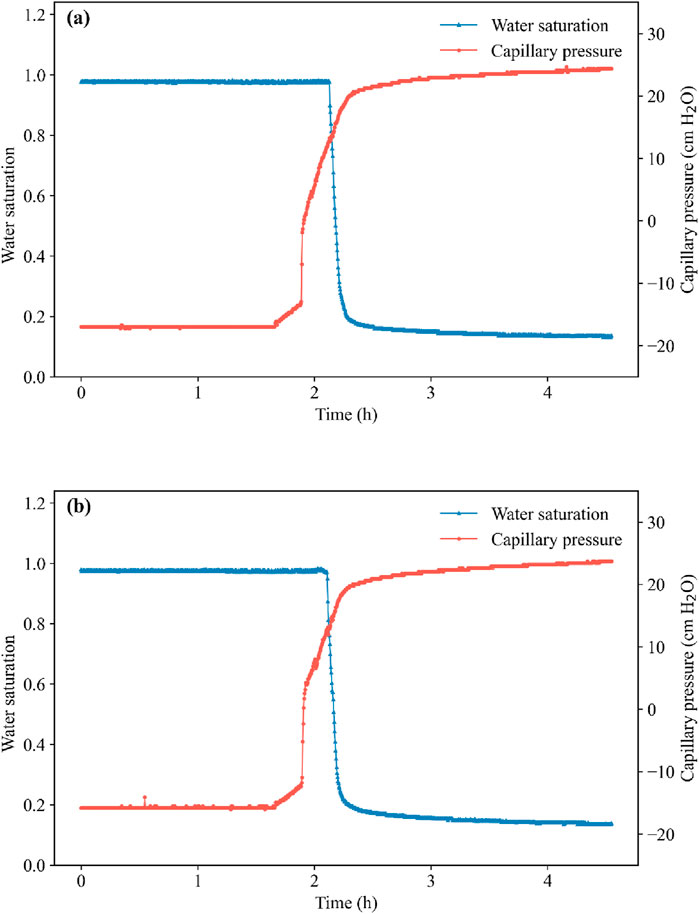
Figure 8. Primary drainage dynamics: Water saturation and capillary pressure for (a) Pristine PS; (b) Aged PS.
Figure 9a,b show capillary pressure (Pc) versus water saturation (Sw) curves during initial drainage for pristine PS and aged PS. During drying (drainage), the advancing air-water interface (AWI) generated significant detachment forces, acting as the key dynamic remobilization mechanism for retained microplastics, particularly hydrophobic ones. Post-drying, capillary forces retained residual water as relatively stable water films or pendular rings (Li et al., 2013), creating potential static retention sites via associated AWIs.
During subsequent wetting phases (Figure 10), Pc and Sw transitioned rapidly before stabilizing. The AWI receded and destabilized, accompanied by water film thickening. While Sw/Pc trends remained largely consistent across cycles, subsequent wetting phases never re-attained complete saturation (Sw = 1.0) due to incomplete air displacement and persistent gas entrapment within pores after multiple cycles (Li et al., 2014), generating new AWIs and water films.
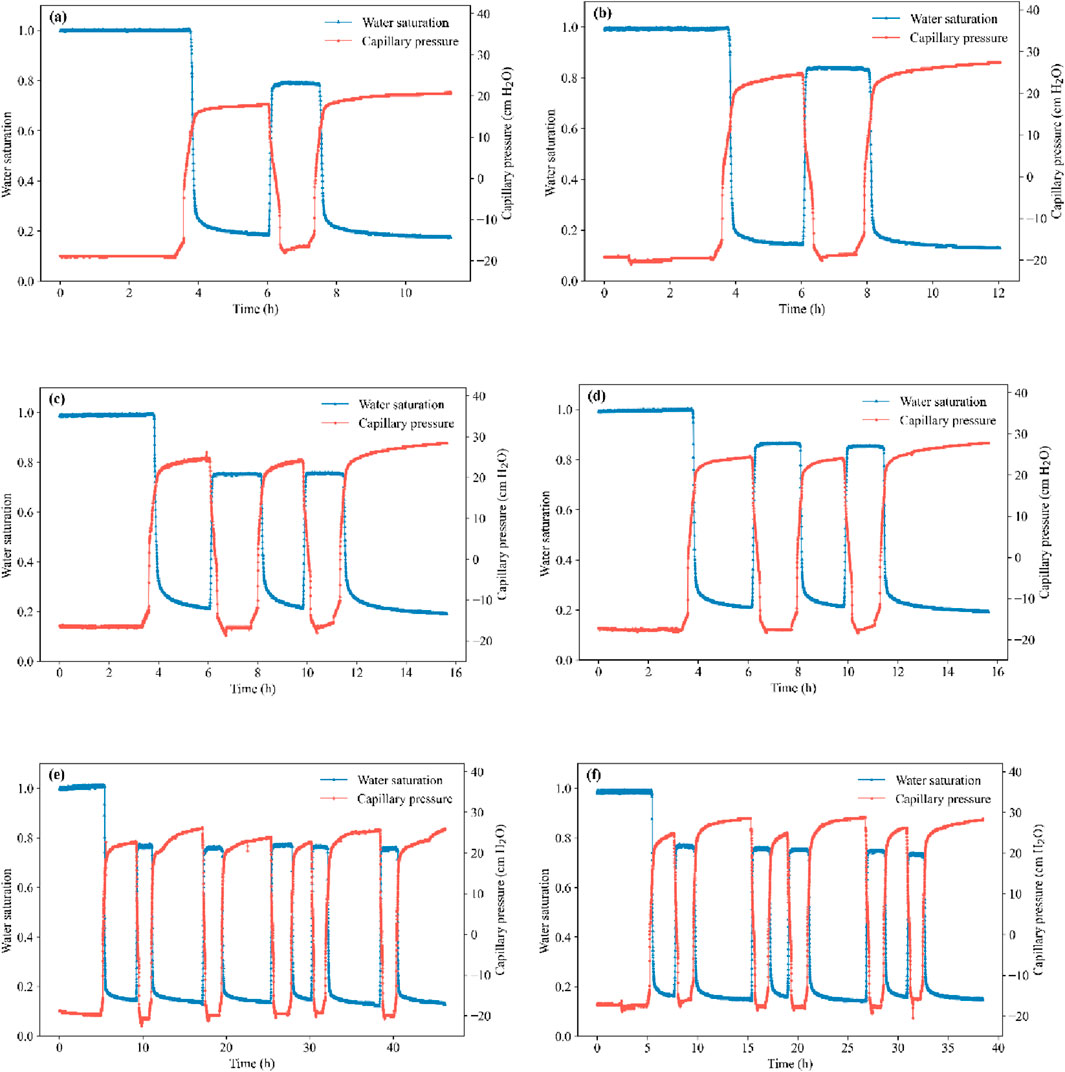
Figure 10. Cyclic wetting-drying dynamics: Water saturation and capillary pressure for Cycle 1 (a,b), Cycle 2 (c,d), Cycle 5 (e,f). (Pristine PS: (a,c,e) Aged PS: (b,d,f)).
Consequently, AWIs exhibit dual functionality: enabling dynamic remobilization during phase transitions (drainage) and providing static retention potential via stabilized interfaces. This interplay introduces significant complexity to microplastic retention and release dynamics.
Figure 11 shows capillary pressure (Pc) versus water saturation (Sw) curves during 1, 2, and 5 wetting-drying cycles. Similar Pc-Sw trajectories across cycles indicate that repeated cycling did not significantly alter the porous media’s pore size distribution. Distinct hysteresis loops formed between drainage and wetting curves (Zhou et al., 2014), arising from pore geometry, contact angle hysteresis at the three-phase contact line, and air entrapment.
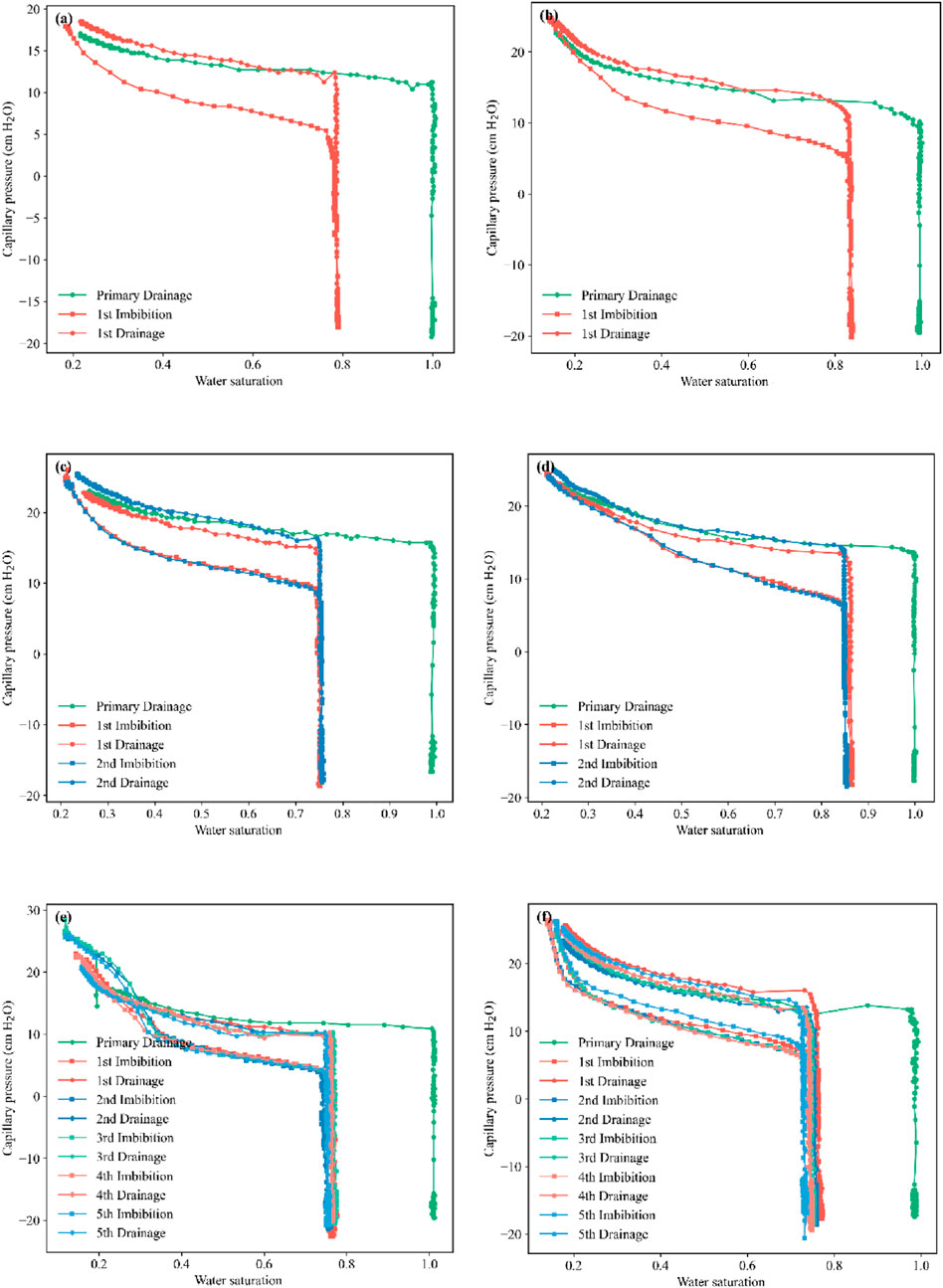
Figure 11. Cyclic wetting-drying water retention curves: Cycle 1 (a,b), Cycle 2 (c,d), Cycle 5 (e,f). (Pristine PS: (a,c,e) Aged PS: (b,d,f)).
At identical Pc values, Sw was lower during drainage than wetting. This phenomenon arises because drainage exhibits more extensive AWIs and thinner water films, providing greater potential for static retention via capillary pinning at the solid-water interface (SWI). Conversely, higher Sw during wetting corresponds to reduced AWI area and thicker water films. This hysteresis demonstrates differing retention/release efficiencies between phases: drainage governs microplastic mobility through competition between enhanced static retention potential and strong dynamic detachment forces, while wetting phases exhibit comparatively weaker interfacial retention. The ultimate fate of microplastics depends on their intrinsic properties interacting with these dynamic environmental factors.
3.2.2 Remobilization behavior of aged microplastics in unsaturated porous media
Figure 12 demonstrates that microplastic release ratios (C/C0) increase as water saturation (Sw) decreases below ∼0.6 during unsaturated drainage. This occurs because the advancing air-water interface (AWI) thins water films, enabling capillary menisci to exert interfacial detachment forces on attached microplastics along the air-water-solid contact line. Release initiates when these detachment forces overcome microplastic adhesion to the solid surface (Sharma et al., 2008). The release threshold at Sw ≈ 0.6 reflects the critical saturation where water films achieve sufficient thinness for the moving AWI to exert significant detachment forces at the solid-water interface (SWI) (Zhang et al., 2012).
This phenomenon parallels nanomaterial transport studies, where E. coli mobilization similarly peaks below Sw = 0.6 as thinning films detach cells from the SWI and transfer them to mobile phases (bulk water or AWI) (Bradford and Torkzaban, 2013). This confirms the AWI’s critical role in colloid mobilization, providing a mechanistic basis for analyzing aging’s impact on microplastic mobility. Crucially, aged PS exhibited lower C/C0 than pristine PS at identical Sw during initial drainage, indicating enhanced detachment resistance.
Figure 13 further shows reduced release recovery for aged PS during initial drainage (12.05% → 7.96%), confirming suppressed remobilization. Although aging enhanced hydrophilicity and electronegativity—potentially weakening adhesion via electrostatic repulsion—unsaturated drainage is dominated by AWI detachment forces. These forces are critically dependent on contact angle: lower contact angles (higher hydrophilicity) reduce capillary pinning at the air-water-solid (AWS) interface, thereby weakening detachment forces (Scheludko et al., 1976). Given that AWI detachment forces exceed electrostatic and hydrodynamic forces by orders of magnitude (Hou et al., 2020), hydrophilicity becomes the governing factor, overriding any mobility promotion from increased electronegativity.
Additionally, aging-induced surface cracks (Figure 5) increase roughness, which enhances adhesion energy and impedes AWI movement across the microplastic surface (Singh and Joseph, 2005). Collectively, hydrophilicity-driven reduction in detachment forces and roughness-enhanced retention significantly reduce aged microplastic mobility in unsaturated porous media.
3.2.3 Effect of cycle number on Re-release behavior
To assess the remobilization potential of retained microplastics, wetting-drying cycles were implemented following initial drainage. Unlike initial drainage, secondary and tertiary drainage phases were preceded by wetting phases (Figure 14). During wetting, water displaced pore air, increasing water saturation (Sw) while decreasing capillary pressure (Pc), with water preferentially invading smaller pores under higher Pc.
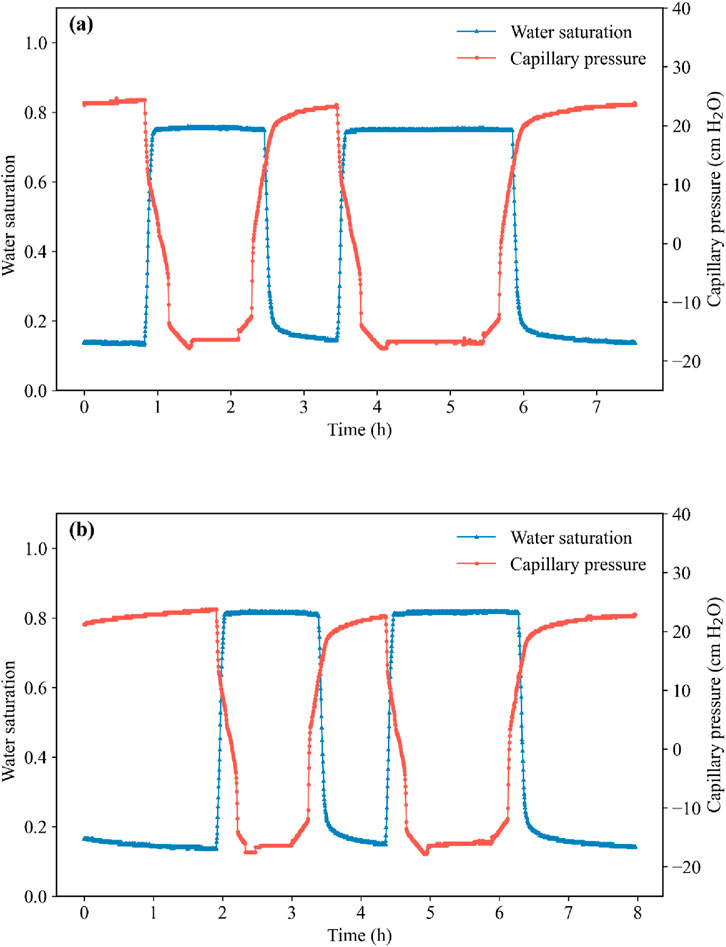
Figure 14. Multi-cycle wet-dry dynamics: Water saturation and capillary pressure for (a) Pristine PS; (b) Aged PS.
Throughout cycling, the Pc-Sw relationship exhibited consistent hysteresis (Figure 15), demonstrating path dependence between wetting and drying phases (Topp et al., 1967). Each drainage phase reduced Sw below the critical threshold established during initial drainage, indicating that re-established mobile air-water interfaces (AWIs) regained potential to remobilize microplastics near the solid-water interface (SWI). Crucially, the wetting phase reintroduced water, disrupting pre-existing AWIs and water films, thereby remobilizing microplastics attached to these interfaces. The distinct hydrodynamic conditions between phases consequently led to phase-dependent remobilization behaviors.
Release recovery rates progressively decreased with increasing cycle number (Figure 13). This decline was more pronounced for aged microplastics: aged PS recovery decreased from 7.96% (initial drainage) to 4.43% (secondary drainage), becoming undetectable during tertiary drainage. Despite similar hydraulic conditions conducive to release in subsequent drainage phases, observed release behavior differed significantly. Both pristine and aged PS exhibited substantially lower recovery in later cycles, indicating markedly reduced mobility in unsaturated porous media after multiple cycles. Residual microplastics demonstrated long-term retention characteristics. This persistent low recovery occurred because each release event selectively mobilized weakly adhering particles (Bradford and Torkzaban, 2013). Consequently, residual microplastics after multiple cycles represent a strongly adhering, less mobile fraction with higher retention stability (Chen et al., 2015).
Aging critically altered microplastic surface properties: enhanced hydrophilicity substantially weakened AWI detachment forces. Additionally, under low saturation conditions, pore water existed as isolated films or pendular rings, trapping microplastics and impeding AWI-mediated release (Feng et al., 2024). These factors collectively rendered aged microplastics highly resistant to release after multiple cycles.
3.3 Cumulative retention behavior of aged microplastics in unsaturated media
3.3.1 Effect of aging on microplastic retention and accumulation in unsaturated media
Figure 16 shows cumulative retention rates for pristine and aged microplastics after 1, 2, and 5 wetting-drying cycles. Aged microplastics consistently exhibited higher retention than their pristine counterparts at each cycle stage, demonstrating that aging promotes long-term retention under repeated cycling.
Although aging enhanced microplastic electronegativity—increasing electrostatic repulsion with porous media—the dominant unsaturated removal mechanism, detachment at the air-water interface (AWI) during drainage, was significantly weakened by aging-induced hydrophilicity. Concurrently, the hysteresis-driven drying path created thinner water films and potentially stronger capillary pinning forces, enhancing static retention potential. Consequently, aged microplastics showed substantially lower removal efficiency than pristine particles during each drying phase, characterized by specific moisture distribution under hysteresis effects.
Following 32-day aging, all microplastics exhibited increased surface roughness. When the colloid-to-grain size ratio (dp/d50) exceeds ∼0.5–1%, physical retention mechanisms (pore straining, mechanical interlocking) become significant alongside chemical attachment (Bradford et al., 2007). In unsaturated media, air occupying pore space narrows effective pathways, likely enhancing physical retention of aged microplastics. Repeated injections during cycles further increased retention sites and physical straining efficiency.
Given the ∼1% size ratio in this system and the complex geometry of unsaturated pores, physical retention emerged as a key mechanism. Increased roughness promotes aged microplastic retention during wetting-drying cycles (Fei et al., 2022), making them more susceptible to entrapment during flow perturbations.
Although aging-enhanced electrostatic repulsion initially inhibited chemical attachment during wetting, this effect was ultimately overridden by drastically reduced removal efficiency during the drainage phase over long-term cycling. Consequently, under the dominance of physical retention and diminished removal efficiency, cumulative retention of aged microplastics exceeded that of pristine particles.
After 5 cycles, retention rates for pristine and aged PS were 11.05% vs 9.38% (bottom) and 3.76% vs 5.48% (surface). Aging produced a more uniform vertical distribution due to enhanced hydrophilicity and electronegativity, which stabilized dispersion and prevented localized accumulation at the inlet or interfaces.
Physical retention occurred throughout the migration path as pore-straining structures (dp/d50 > 0.5–1%) were widely distributed (Chen et al., 2008), resulting in random-depth retention of aged microplastics via physical mechanisms. While pristine microplastics underwent AWI-driven re-concentration, aged particles demonstrated weaker attachment, enabling short-distance detachment/re-attachment during flow and exhibiting limited AWI-driven transport (Wu et al., 2019). Combined with repeated flushing and retention, this yielded a more homogeneous spatial distribution of aged microplastics. Aging thus simultaneously enhanced cumulative retention—through reduced removal and increased physical trapping—and distribution uniformity via weak attachment and low remobilization.
3.3.2 Effect of cycle number on cumulative retention behavior
As presented in Table 1, the cumulative retention rates of pristine PS microplastics increased progressively to 22.94%, 38.97%, and 72.83% after 1, 2, and 5 wetting-drying cycles, respectively. Aged PS exhibited even higher retention, reaching 76.88% after 5 cycles. Retention significantly increased with cycle number for both microplastic types, although the accumulation rate gradually declined. This demonstrates that repeated cycling enhanced microplastic retention within the porous media by progressively strengthening retention mechanisms while weakening removal processes.
For all microplastics, particles exhibiting weaker adhesion—those more readily mobilized by air-water interfaces (AWIs)—were likely removed during initial cycles, leaving behind a population of increasingly stable particles. Furthermore, repeated microplastic injections during wetting phases continuously introduced new particles to occupy available retention sites. Physical straining mechanisms also intensified over successive cycles: newly injected particles became strained at pore throats or adhered to rough surfaces, while previously retained particles formed “filter layers” that captured incoming particles. These cumulative effects amplified retention with increasing cycle number.
Figure 17 illustrates the vertical distribution of pristine and aged microplastics after 1, 2, and 5 cycles. Retention was consistently higher in the bottom layer (36–40.5 cm depth: pristine PS 6.20%–11.05%; aged PS 6.60%–9.38%) compared to the surface layer (0–4.5 cm: pristine PS 0.75%–3.76%; aged PS 0.75%–5.48%). However, distributions became increasingly uniform with progressive cycling.
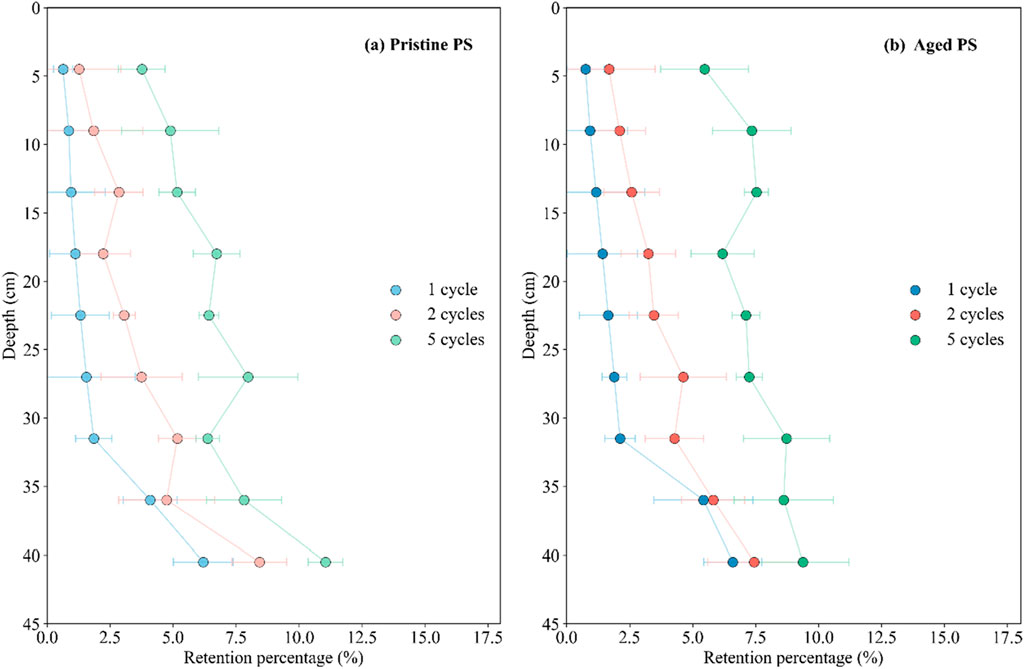
Figure 17. Vertical distribution of retained microplastics after wet-dry cycles: Pristine PS vs Aged PS (Cycles 1, 2, 5).
In porous media where pore throat diameters exceed microplastic particle sizes, particles can theoretically migrate upward (Gibson et al., 2009). The observed elevated bottom retention likely resulted from the formation of “filter layers” near the inlet, where embedded particles captured subsequently arriving microplastics.
During cycling, mobile AWIs remobilized retained particles, including those within filter layers. These remobilized particles were transported upward with pore water flow and subsequently re-retained at various depths due to hydrodynamic shifts or interface collapse. This cyclic capture-transport-re-retention process continuously redistributed particles vertically.
Concurrently, flow perturbations enabled physical straining throughout the column. Under the combined influence of AWI remobilization, flow-driven retention, and inherent transport properties, repeated wetting-drying cycles progressively homogenized the spatial distribution of microplastics.
4 Conclusion
This study systematically investigated the regulatory mechanisms governing retention and release dynamics of aged microplastics (MPs) in unsaturated porous media under cyclic wetting-drying conditions, revealing dominant transport mechanisms and key hydrodynamic drivers. Key findings include:
(1) Aging fundamentally modified MPs’ physicochemical properties, significantly increasing surface electronegativity and hydrophilicity.
(2) During unsaturated drying phases, aging suppressed remobilization of retained MPs. Aged MPs exhibited substantially lower release efficiency than pristine MPs, with release dominated by the moving air-water interface (AWI) where hydrophobicity governs detachment. MPs undergo remobilization via capillary separation forces at the advancing AWI when water saturation falls below a critical threshold (∼0.6).
(3) Under cyclic wetting-drying with continuous MP influx, aging significantly enhanced long-term retention while promoting vertical distribution homogeneity. After 5 cycles, cumulative retention of aged MPs (76.88%) consistently exceeded that of pristine particles (72.83%). This enhanced retention is attributed primarily to aging-induced surface roughness enhancing physical straining mechanisms. Critically, the cumulative effect of these retention-promoting factors outweighed aging-enhanced electrostatic repulsion during wetting phases.
Data availability statement
The original contributions presented in the study are included in the article/supplementary material, further inquiries can be directed to the corresponding authors.
Author contributions
XJ: Data curation, Formal Analysis, Funding acquisition, Investigation, Methodology, Project administration, Resources, Validation, Writing – original draft. XH: Formal Analysis, Investigation, Methodology, Validation, Writing – original draft. YL: Formal Analysis, Investigation, Methodology, Writing – original draft. YS: Data curation, Formal Analysis, Resources, Validation, Writing – original draft. ZS: Writing – original draft. HQ: Writing – original draft, Writing – review and editing, Conceptualization, Data curation, Formal Analysis, Funding acquisition, Investigation, Methodology, Project administration, Resources, Software, Supervision, Validation, Visualization. LY: Conceptualization, Data curation, Formal Analysis, Funding acquisition, Investigation, Methodology, Project administration, Resources, Software, Supervision, Validation, Visualization, Writing – original draft, Writing – review and editing.
Funding
The author(s) declare that financial support was received for the research and/or publication of this article. This work was supported by the Chinese National Science Foundation (grant no. 41772237), Innovation Group Project of Southern Marine Science and Engineering Guangdong Laboratory (Zhuhai) (grant no. 311022004), Guangdong MEPP (Marine Economy Promotion Projects) Fund (grant no. GDOE–[2019]–A41), and Special Project for Research and Development in Key areas of Guangdong Province (No. 2020B1111350003).
Conflict of interest
Author SY was employed by Zhejiang Zhouhuan Environmental Engineering Design Co., Ltd.
The remaining authors declare that the research was conducted in the absence of any commercial or financial relationships that could be construed as a potential conflict of interest.
Generative AI statement
The author(s) declare that no Generative AI was used in the creation of this manuscript.
Publisher’s note
All claims expressed in this article are solely those of the authors and do not necessarily represent those of their affiliated organizations, or those of the publisher, the editors and the reviewers. Any product that may be evaluated in this article, or claim that may be made by its manufacturer, is not guaranteed or endorsed by the publisher.
References
Abaroa-Pérez, B., Ortiz-Montosa, S., Hernández-Brito, J. J., and Vega-Moreno, D. (2022). Yellowing, weathering and degradation of marine pellets and their influence on the adsorption of chemical pollutants. Polymers 14 (7), 1305. doi:10.3390/polym14071305
Akhatova, F., Ishmukhametov, I., Fakhrullina, G., and Fakhrullin, R. (2022). Nanomechanical atomic force microscopy to probe cellular microplastics uptake and distribution. International J. Mol. Sci. 23 (2), 806. doi:10.3390/ijms23020806
Bradford, S. A., and Torkzaban, S. (2008). Colloid transport and retention in unsaturated porous media: a review of interface-collector-and pore-scale processes and models. Vadose Zone J. 7 (2), 667–681. doi:10.2136/vzj2007.0092
Bradford, S. A., and Torkzaban, S. (2013). Colloid interaction energies for physically and chemically heterogeneous porous media. Langmuir 29 (11), 3668–3676. doi:10.1021/la400229f
Bradford, S. A., Torkzaban, S., and Walker, S. L. (2007). Coupling of physical and chemical mechanisms of colloid straining in saturated porous media. Water Res. 41 (13), 3012–3024. doi:10.1016/j.watres.2007.03.030
Chen, L., Sabatini, D. A., and Kibbey, T. C. (2008). Role of the air–water interface in the retention of TiO2 nanoparticles in porous media during primary drainage. Environ. Sci. and Technol. 42 (6), 1916–1921. doi:10.1021/es071410r
Chen, L.-C., Papandreou, G., Kokkinos, I., Murphy, K., and Yuille, A. L. (2015). Semantic image segmentation with deep convolutional nets and fully connected CRFs. ICLR, 3431–3440. doi:10.48550/arXiv.1412.7062
Crist, J. T., Zevi, Y., McCarthy, J. F., Throop, J. A., and Steenhuis, T. S. (2005). Transport and retention mechanisms of colloids in partially saturated porous media. Vadose Zone J. 4 (1), 184–195. doi:10.2136/vzj2005.0184
Dong, S., Zhou, M., Su, X., Xia, J., Wang, L., Wu, H., et al. (2022). Transport and retention patterns of fragmental microplastics in saturated and unsaturated porous media: a real-time pore-scale visualization. Water Res. 214, 118195. doi:10.1016/j.watres.2022.118195
Fei, J., Xie, H., Zhao, Y., Zhou, X., Sun, H., Wang, N., et al. (2022). Transport of degradable/nondegradable and aged microplastics in porous media: effects of physicochemical factors. Sci. Total Environ. 851, 158099. doi:10.1016/j.scitotenv.2022.158099
Feng, Q., An, C., Chen, Z., and Wang, Z. (2023). New perspective on the mobilization of microplastics through capillary fringe fluctuation in a tidal aquifer environment. Environ. Sci. and Technol. 57 (2), 929–938. doi:10.1021/acs.est.2c04686
Feng, Q., Chen, Z., Greer, C. W., and Wang, Z. (2022). Transport of microplastics in shore substrates over tidal cycles: roles of polymer characteristics and environmental factors. Environ. Sci. and Technol. 56 (12), 8187–8196. doi:10.1021/acs.est.2c01599
Feng, Q., Chen, Z., Huang, G., An, C., Yang, X., and Wang, Z. (2024). Prolonged drying impedes the detachment of microplastics in unsaturated substrate: role of flow regimes. Water Res. 252, 121246. doi:10.1016/j.watres.2024.121246
Flury, M., and Aramrak, S. (2017). Role of air-water interfaces in colloid transport in porous media: a review. Water Resour. Res. 53 (7), 5247–5275. doi:10.1002/2017wr020597
Gao, J., Pan, S., Li, P., Wang, L., Hou, R., Wu, W. M., et al. (2021). Vertical migration of microplastics in porous media: multiple controlling factors under wet-dry cycling. J. Hazard. Mater. 419, 126413. doi:10.1016/j.jhazmat.2021.126413
Gibson, S., Abraham, D., Heath, R., and Schoellhamer, D. (2009). Vertical gradational variability of fines deposited in a gravel framework. Sedimentology 56 (3), 661–676. doi:10.1111/j.1365-3091.2008.00991.x
He, H., Wu, T., Chen, Y. F., and Yang, Z. (2023). A pore-scale investigation of microplastics migration and deposition during unsaturated flow in porous media. Sci. Total Environ. 858, 159934. doi:10.1016/j.scitotenv.2022.159934
Hou, J., Xu, X., Lan, L., Miao, L., Xu, Y., You, G., et al. (2020). Transport behavior of micro polyethylene particles in saturated quartz sand: impacts of input concentration and physicochemical factors. Environ. Pollut. 263, 114499. doi:10.1016/j.envpol.2020.114499
Huang, W., Li, Y., Du, Y., He, X., Li, C., Xi, J., et al. (2024). Factors influencing residual air saturation during consecutive imbibition processes in an air-water two-phase fine sandy medium–a laboratory-scale experimental study. J. Contam. Hydrology 266, 104416. doi:10.1016/j.jconhyd.2024.104416
Koelmans, A. A., Redondo-Hasselerharm, P. E., Nor, N. H. M., de Ruijter, V. N., Mintenig, S. M., and Kooi, M. (2022). Risk assessment of microplastic particles. Nat. Rev. Mater. 7 (2), 138–152. doi:10.1038/s41578-021-00411-y
Lau, W. W., Shiran, Y., Bailey, R. M., Cook, E., Stuchtey, M. R., Koskella, J., et al. (2020). Evaluating scenarios toward zero plastic pollution. Science 369 (6510), 1455–1461. doi:10.1126/science.aba9475
Li, W., Zu, B., Yang, Q., Guo, J., and Li, J. (2023). Sources, distribution, and environmental effects of microplastics: a systematic review. RSC Adv. 13 (23), 15566–15574. doi:10.1039/d3ra02169f
Li, Y., Flores, G., Xu, J., Yue, W. z., Wang, Y. x., Luan, T. g., et al. (2013). Residual air saturation changes during consecutive drainage– imbibition cycles in an air–water fine sandy medium. J. Hydrology 503, 77–88. doi:10.1016/j.jhydrol.2013.08.050
Li, Y., Wu, P., Xia, Z., Yang, Q., Flores, G., Jiang, H., et al. (2014). Changes in residual air saturation after thorough drainage processes in an air–water fine sandy medium. J. Hydrology 519, 271–283. doi:10.1016/j.jhydrol.2014.07.019
Ling, X., Yan, Z., and Lu, G. (2022). Vertical transport and retention behavior of polystyrene nanoplastics in simulated hyporheic zone. Water Res. 219, 118609. doi:10.1016/j.watres.2022.118609
Lu, Q., Zhou, Y., Sui, Q., and Zhou, Y. (2023). Mechanism and characterization of microplastic aging process: a review. Front. Environ. Sci. and Eng. 17 (8), 100. doi:10.1007/s11783-023-1700-6
Mitropoulou, P. N., Syngouna, V. I., and ChrysiKopoulos, C. V. (2013). Transport of colloids in unsaturated packed columns: role of ionic strength and sand grain size. Chem. Eng. J. 232, 237–248. doi:10.1016/j.cej.2013.07.093
Morales, V. L., Zhang, W., Gao, B., Lion, L. W., Bisogni, J. J., McDonough, B. A., et al. (2011). Impact of dissolved organic matter on colloid transport in the vadose zone: deterministic approximation of transport deposition coefficients from polymeric coating characteristics. Water Res. 45 (4), 1691–1701. doi:10.1016/j.watres.2010.10.030
O’connor, D., Pan, S., Shen, Z., Song, Y., Jin, Y., Wu, W. M., et al. (2019). Microplastics undergo accelerated vertical migration in sand soil due to small size and wet-dry cycles. Environ. Pollut. 249, 527–534. doi:10.1016/j.envpol.2019.03.092
Ouyang, Z., Li, S., Zhao, M., Wangmu, Q., Ding, R., Xiao, C., et al. (2022). The aging behavior of polyvinyl chloride microplastics promoted by UV-activated persulfate process. J. Hazard. Mater. 424, 127461. doi:10.1016/j.jhazmat.2021.127461
Ranjan, V. P., Joseph, A., Sharma, H. B., and Goel, S. (2023). Preliminary investigation on effects of size, polymer type, and surface behaviour on the vertical mobility of microplastics in a porous media. Sci. Total Environ. 864, 161148. doi:10.1016/j.scitotenv.2022.161148
Ren, Z., Gui, X., Wei, Y., Chen, X., Xu, X., Zhao, L., et al. (2021). Chemical and photo-initiated aging enhances transport risk of microplastics in saturated soils: key factors, mechanisms, and modeling. Water Res. 202, 117407. doi:10.1016/j.watres.2021.117407
Scheludko, A., Toshev, B., and Bojadjiev, D. (1976). Attachment of particles to a liquid surface (capillary theory of flotation). J. Chem. Soc. Faraday Trans. 1 Phys. Chem. Condens. Phases 72, 2815–2828. doi:10.1039/f19767202815
Sharma, P., Flury, M., and Zhou, J. (2008). Detachment of colloids from a solid surface by a moving air– water interface. J. Colloid Interface Sci. 326 (1), 143–150. doi:10.1016/j.jcis.2008.07.030
Singh, P., and Joseph, D. (2005). Fluid dynamics of floating particles. J. Fluid Mech. 530, 31–80. doi:10.1017/S0022112005003575
Topp, G. C., Klute, A., and Peters, D. B. (1967). Comparison of water content-pressure head data obtained by equilibrium, steady-state, and unsteady-state methods. Soil Sci. Soc. America J. 31 (3), 312–314.
Wang, L., Zhang, J., Huang, W., and He, Y. (2023). Laboratory simulated aging methods, mechanisms and characteristic changes of microplastics: a review. Chemosphere 315, 137744. doi:10.1016/j.chemosphere.2023.137744
Wang, X., Diao, Y., Dan, Y., Liu, F., Wang, H., Sang, W., et al. (2022). Effects of solution chemistry and humic acid on transport and deposition of aged microplastics in unsaturated porous media. Chemosphere 309, 136658. doi:10.1016/j.chemosphere.2022.136658
Wu, P., Cai, Z., Jin, H., and Tang, Y. (2019). Adsorption mechanisms of five bisphenol analogues on PVC microplastics. Sci. Total Environ. 650, 671–678. doi:10.1016/j.scitotenv.2018.09.049
Wu, T., Yang, Z., Hu, R., Chen, Y. F., Zhong, H., Yang, L., et al. (2021). Film entrainment and microplastic particles retention during gas invasion in suspension-filled microchannels. Water Res. 194, 116919. doi:10.1016/j.watres.2021.116919
Xi, X., Ding, D., Zhou, H., Baihetiyaer, B., Sun, H., Cai, Y., et al. (2022). Interactions of pristine and aged nanoplastics with heavy metals: enhanced adsorption and transport in saturated porous media. J. Hazard. Mater. 437, 129311. doi:10.1016/j.jhazmat.2022.129311
Xie, X. X., Li, Y., Xia, B. C., Xu, L. m., Su, Y., and Gu, Q. b. (2012). Hysteresis of saturation-capillary pressure relations under consecutive drainage-imbibition cycles in fine sandy medium. J. Central South Univ. 19 (1), 222–230. doi:10.1007/s11771-012-0995-4
Yu, F., Qin, Q., Zhang, X., and Ma, J. (2024). Characteristics and adsorption behavior of typical microplastics in long-term accelerated weathering simulation. Environ. Sci. Process. and Impacts 26 (5), 882–890. doi:10.1039/d4em00062e
Zhang, Q., Hassanizadeh, S. M., Raoof, A., van Genuchten, M., and Roels, S. M. (2012). Modeling virus transport and remobilization during transient partially saturated flow. Vadose Zone J. 11 (2), vzj2011–vzj2090. doi:10.2136/vzj2011.0090
Keywords: microplastics, aging, drying-wetting cycle, unsaturated porous media, air-water interface
Citation: Jingya X, Han X, Lingzhi Y, Yijia S, Shuyi Z, Qing H and Yan L (2025) Retention and remobilization of aged polystyrene (PS) microplastics in a porous medium under wet-dry cycling. Front. Environ. Sci. 13:1639535. doi: 10.3389/fenvs.2025.1639535
Received: 02 June 2025; Accepted: 30 June 2025;
Published: 14 July 2025.
Edited by:
Guodong Cao, China University of Geosciences Wuhan, ChinaReviewed by:
Omowunmi H. Fred-Ahmadu, Afe Babalola University, NigeriaShen Tingting, Taizhou University, China
Hongli Tan, Jinan University, China
Copyright © 2025 Jingya, Han, Lingzhi, Yijia, Shuyi, Qing and Yan. This is an open-access article distributed under the terms of the Creative Commons Attribution License (CC BY). The use, distribution or reproduction in other forums is permitted, provided the original author(s) and the copyright owner(s) are credited and that the original publication in this journal is cited, in accordance with accepted academic practice. No use, distribution or reproduction is permitted which does not comply with these terms.
*Correspondence: Huang Qing, cWh1YW5nMDkyQDE2My5jb20=; Li Yan, ZWVzbHlAbWFpbC5zeXN1LmVkdS5jbg==
 Xi Jingya1
Xi Jingya1 Huang Qing
Huang Qing